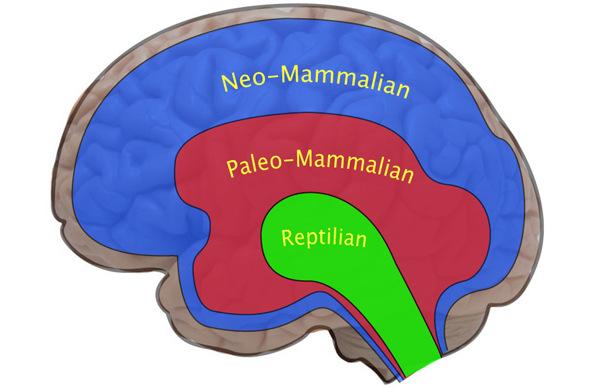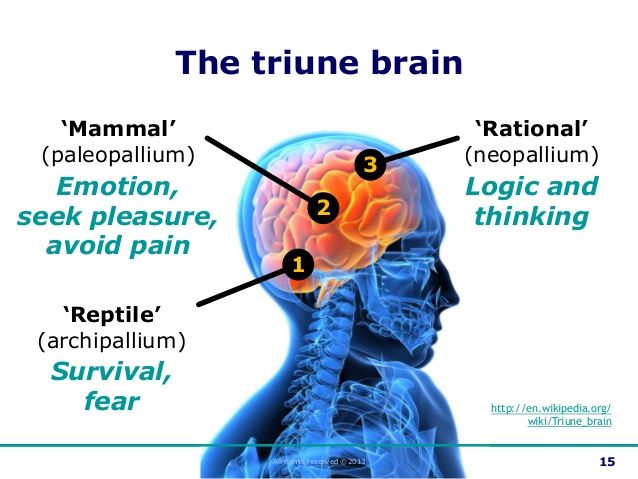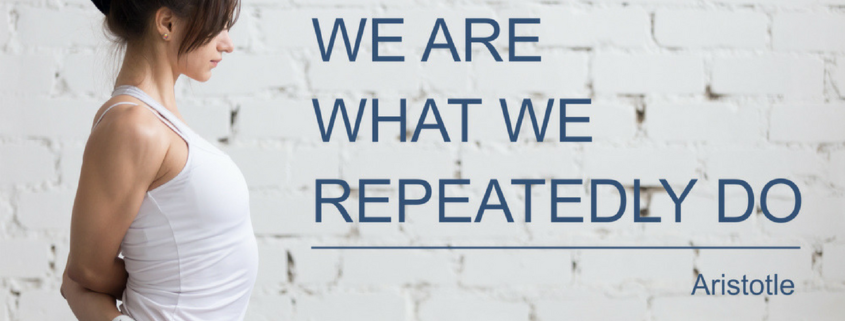To Change or Not to Change
The Mastery of Lifestyle Changes
Change is a constant flow of transformation. Change comes from the intrinsic quality of life, impermanency. While the body changes from moment to moment and time takes us to our inevitable final destination, we are poorly aware of this state of affairs and live our lives as if we were never going to die, acquiring material possessions, fame, money and secular habits. When awareness strikes and we want to make a change, it becomes as frightening as jumping off a cliff. Having lived with the illusion of permanency, fear paralyzes us and we feel powerless. So, why are we clinging to old habits that destroy us, “friends” that abuse us, and meaningless jobs that we hate?
The answer is in THE BRAIN
Our brain has evolved over millions of years, from the simple survival behaviors such as sex and feeding, to the more complex ones such as feeling and thinking. The neuroscientist, Paul MacLean, suggests this theory: that the human brain is composed of three different layers that have evolved over millennia – the triune brain or three brains in one.

The Triune Brain
The Three Layers of the Brain
The deeper and most ancient layer, is the reptilian brain. This layer corresponds to the base chakra and 2nd chakra: It encodes survival of the individual and of the species (feeding and reproduction). It is compulsory in the sense that these behaviors are obligated by nature’s design to conserve itself. Nature rewards these behaviors with pleasure as a motivation to perform them. The next layer, the limbic system, corresponds to the 3rd and 4th chakra. It is the center of emotions, learning, and memory formation. The limbic system evaluates the pleasantness or unpleasantness of experiences. It is the center of the fight or flight response and the dopamine reward system that plays such an important role in habit forming. The cortex, the most recent layer, which corresponds to the throat and third eye chakra, is the higher processing center of our brain, and the center of rational thinking. It can recall past memories, project into the future and learn language. It is the center of our will, judgment, compassion, and mindfulness. The neocortex provides the basis for self-awareness, in addition to intellectual function. In the same way the chakras collect energy from the previous lower level, each layer of the brain gathers information from the deeper brain and the body through the nervous system, informing us about the quality of the environment and of our inner state.

The Brain as Friend and Foe
According to this design, the brain is sending potentially conflicting messages depending on the part which sends it. While habits get stored in the basal ganglia, our will to change sits in the prefrontal cortex. Now, the brain that wanted to make our life easier by learning a habit, resists the conscious part of the brain that wants to change it. The only hitch: it learnt a bad habit that may be detrimental to our survival. For instance, we got into the habit of smoking when we were young because we were modeling our respectable adults and when we became aware of the harmful nature of this habit and wanted to quit, we could not. The compulsory part of the brain is ruling our behavior to the detriment of our free will. To reverse this situation and make the brain follow our decisions rather than oppose them, we must examine how habits get formed. And, how and why we learned them, so that we may be able to erase what we don’t want and create what we freely choose.
Habit forming is initiated by the brain’s desire to learn, which is rendered possible by its malleability. The ability to learn is what enables us to establish habits. We are adventurous, avid for new knowledge and we love learning.
As children, we learned how to walk and how to talk through imitation and repetition. The blueprint of those habits were stored in our brain forever in the form of neurons firing together in specific pathways. Habits became unconscious freeing our time for other adventures. While we are walking we can hold a conversation with a friend while our brain works for us. Tripping on a stone will wake us up and bring our walking to the forefront of our awareness again. So, unconscious habits can be made conscious again, should we need to or choose them to.
Learning occurs through emulation and self-emulation, which is supported by the dopamine reward system of the brain: From crawling to standing, we were inspired by our parent’s smiles and rewarded by their encouragements. A positive feedback loop was established with the environment and within us. As we grew into adulthood, we became self-motivated as we learned a new language, how to play tennis, or as we learned a new job.
Learning also occurs through repetition. How many times did we stand up and walked again after a fall? As we moved through life, we learned to not only master sports and other tasks, but also fears, and poor behaviors.
The brain can project into the future, recall the past, and reflect on itself. Its love for betterment is what motivates us to make changes. The brain learns by setting experiences into patterns that will eventually be the control center of automatic behaviors. This programming has the advantage of freeing our attention for other matters, but does not allow for an original and spontaneous answer. Therefore, patterns are rigid. The good news is that we have the ability to appeal to the frontal lobe cortex to supersede any habitual behavior by a spontaneous response.
The brain is non-judgmental and does not distinguish between good and bad habits.
The brain is not picky about the quality of the habits it is forming. The brain does not have a judgment or a philosophy about what is good and what is bad. The problem comes with the negative offerings of our modern world. Our brain was wired for a supporting and loving environment therefore learning self-confidence and love. But in an unsafe environment humans will learn insecurity, mistrust and fear of intimacy. Our brain is wired to associate food and love. If our mother served us a microwave frozen pizza for dinner our brain will associate pizza and love. We will love pizza and continue eating pizza through our life unless…. our frontal cortex wakes up the sleepy bear and understands the connection between processed food, bloating and weight gain.
We engage on the path of change when bad habits became detrimental to our physical, emotional, or spiritual health. The instant pleasure derived from them is not worth the long term discomfort that they create. When we start to make a change, is when the battle begins between the different parts of the brain. The deeper part of the brain function is to hold on to habits good or bad. The good news again is that bad habits can be reversed, thanks to the malleability and self-awareness of the brain.
THE MASTERY OF LIFESTYLE CHANGE
The Path of the Hero
Overcoming Resistance to Change
Resistance to change is due to the prevalence of established patterns associated with set rewarding pathways in the brain.
We want to change but we cannot. We tried to quit smoking many times but we relapsed. We want to be positive, but this alter voice says nasty words of anger and judgment.
To overcome the brain resistance to change, the old pathways need to be deserted and new ones need to be built. Change is not instantaneous. Changing a habit involves work. In the same way we learned the old habit through motivation and repetition we will have to continue using motivation and repetition to create a new habit. The old pathways will progressively lose their strength as we quit reinforcing them. The thoughts and feelings associated with the behavior will also become less pervasive, but we will need to build a new habit to fulfill similar functions and satisfy the brain’s desire for reward.
MAP to Overcome the Resistance to Change
Motivation, Awareness and Practice are the necessary tools needed by the hero to master the journey of change.
How to break an old habit… First step: Motivation
Bad habits are associated with instant positive reward and a negative long term reward. The pain or the suffering has to attain its threshold before we seek a change. Hopefully, we don’t wait until bad habits develop into disease or illness. Sometimes, the fear of losing a loved one or losing money may create a strong enough motivation to instigate a desire to change. Whatever detrimental behaviors have developed around the practice of bad habits is the common denominator to initiate change, and the desire to be free from our lower self. Attachment to suffering can have deep roots into our upbringing and we may have to investigate patterns acquired as coping mechanism during childhood. Past traumas and history of abuse is the usual background for self-destructive habits. Confronting our fears is an important part of this first step as well as creating a clear vision of our path, consolidated by affirmations about who we want to be. For instance, if we are afraid of sharing our feelings and want to be able to express how we feel, we must overcome the fear by breaking the habit of being silent and speak up.
How to break and old habit… Second step: Awareness and Pause
To overcome the automatic unfolding of a habit we must interrupt it from another part of our brain, the prefrontal cortex. In well-established habits, the thought of smoking or complaining has become unconscious. We grab a cigarette, or complain without thinking about it or being aware of it. We must slow down enough to bring the thought to our awareness. This awareness can be called in any time during the process of performing an old habit. The earlier we catch it, the easier to stop it. The prefrontal cortex is the seat of awareness. So, visualizing the third eye, or tapping the forehead, helps to mobilize awareness. The goal of this phase is to become the watcher or the witness. During this phase there is no doing, just contemplation as the energy is removed from the automatic train of thought and redirected to meditation. It is important during this stage to mobilize the reward system of the brain by reframing our thoughts and deriving instant pleasure from being empowered and in control of the situation. Deriving pleasure in the moment will present a feasible alternative to the brain to go a different route.
How to break an old habit: Third step Practice
Extend the current pleasant experience and repeat. As we extend the time of self-reflection, reframing our desire to smoke and identifying as a non-smoker, we must associate it with pleasure. Take a deep breath of clean air and feel the gratefulness of our lungs. As we stop the complainer or the blaming, we must savor the pleasure of self-empowerment in taking responsibility about our feelings. Then, repeat this new practice over time until it has become a spontaneous reaction and a new healthy learned habit. The pleasure or joy of success associated with the new behavior will create a motivation to continue the learning.
PHYSIOLOGY OF CHANGE
For successful changes, we must work on the psychological level as well as the physiological level. The neuronal pathways carry their impulses through neurons connected to each other’s by chemical messengers, the neurotransmitters. Dopamine, serotonin, oxytocin and endorphins are neurotransmitters that play an important role in the establishment and maintenance of habits. Neurotransmitters and neurons depend on the blood to bring nutrients and oxygen on a constant basis. To rebuild neurotransmitters and neurons we need the appropriate amino acids, anti-oxidants, minerals and vitamins. Those maybe have been depleted by poor lifestyle habits and poor nutrition, toxic exposure to heavy metals and chemicals. Therefore, healthy nutrition and supplementation is of primal importance to rebuild the depleted brain.
SOCIOLOGY OF CHANGE
The environment provides cues that trigger our habits. It is important to remove these cues and to surround ourselves with like-minded people who will provide a positive feedback and support to our newly created habits. For instance, if we want to quit drinking 3 glasses of wine every night with dinner, then it is important to remove wine from our closet and replace the wine with lemon water. It will be important to enjoy drinking the lemon water and feel rewarded by the pleasure that we are exerting from our freedom of choice. Our partner or other family members dining with us, would have to abstain from drinking as well. For more advanced problems with alcohol, we will want to attend meetings with people who are pursuing similar goals, socialize with friends who are not drinking alcohol, and substitute activities like exercise or other active lifestyle choices that will produce the same effect on the brain’s reward system.



